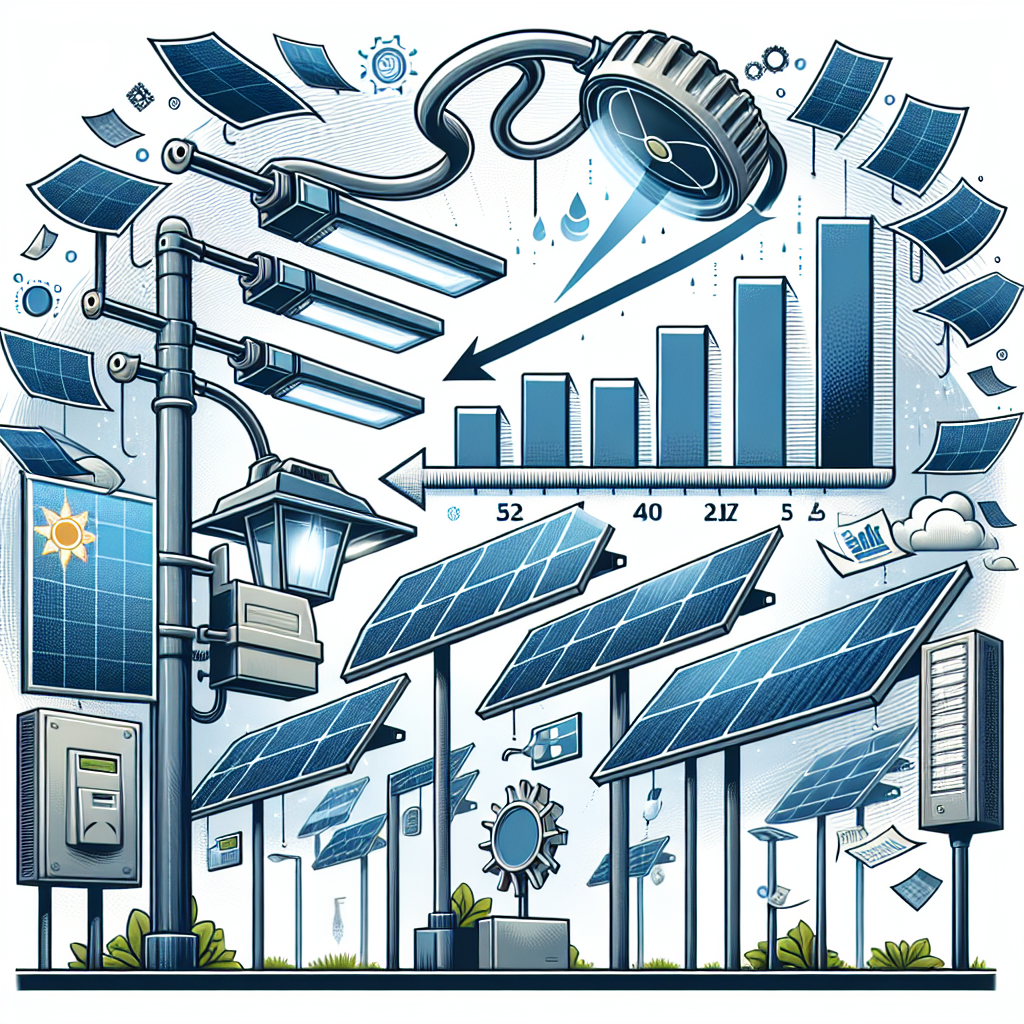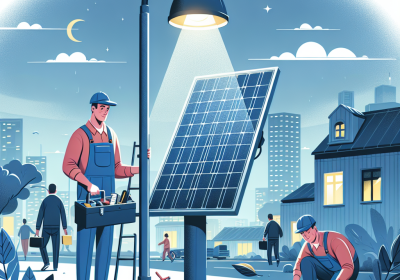Durability and Lifespan of Commercial Solar Street Lights
-
Table of Contents
The durability and lifespan of commercial solar street lights are critical factors that determine their effectiveness and long-term value in urban and rural infrastructure. These solar-powered lighting solutions are designed to withstand various environmental conditions while providing reliable illumination for streets, pathways, and public spaces. The durability of solar street lights is influenced by the quality of materials used, such as weather-resistant casings, robust solar panels, and long-lasting LED bulbs. Additionally, the lifespan of these lights is extended through advanced battery technologies and efficient energy management systems that ensure consistent performance over time. Understanding these aspects is essential for municipalities and businesses looking to invest in sustainable and cost-effective lighting solutions that reduce energy consumption and minimize maintenance costs.
Factors Influencing the Durability of Commercial Solar Street Lights
The durability and lifespan of commercial solar street lights are influenced by a multitude of factors, each playing a crucial role in determining how long these lights can effectively serve their purpose. Understanding these factors is essential for businesses and municipalities considering the investment in solar street lighting solutions. One of the primary factors affecting the durability of solar street lights is the quality of materials used in their construction. High-quality materials, such as corrosion-resistant metals and robust plastics, can significantly enhance the longevity of these lights. For instance, using stainless steel or aluminum for the poles and fixtures can prevent rust and degradation, especially in harsh weather conditions. Similarly, UV-resistant plastics for the light covers can prevent yellowing and brittleness over time.
In addition to material quality, the design and engineering of solar street lights also play a pivotal role in their durability. Well-engineered lights that incorporate features such as efficient heat dissipation systems can prevent overheating, which is a common cause of component failure. Moreover, designs that protect sensitive components from moisture and dust ingress can further extend the lifespan of the lights. The integration of smart technology, such as sensors and adaptive lighting controls, can also contribute to durability by optimizing energy use and reducing wear and tear on the system.
Another significant factor is the quality of the solar panels and batteries used in these systems. High-efficiency solar panels that can capture and convert more sunlight into electricity will ensure that the lights remain operational even during periods of low sunlight. Furthermore, the type and quality of batteries used are critical, as they store the energy needed to power the lights at night. Lithium-ion batteries, for example, are known for their long lifespan and ability to withstand numerous charge and discharge cycles, making them a preferred choice for solar street lights.
Environmental conditions also have a substantial impact on the durability of solar street lights. Locations with extreme weather conditions, such as high winds, heavy rainfall, or intense sunlight, can accelerate the wear and tear of these systems. Therefore, it is essential to select lights that are specifically designed to withstand the local climate. For instance, in areas prone to high winds, lights with aerodynamic designs and sturdy mounting systems are advisable. In regions with frequent rainfall, ensuring that the lights have a high ingress protection (IP) rating can prevent water damage.
Maintenance practices are another crucial factor influencing the lifespan of commercial solar street lights. Regular maintenance, including cleaning the solar panels, checking the battery health, and inspecting the structural integrity of the lights, can prevent minor issues from escalating into major problems. Implementing a proactive maintenance schedule can significantly enhance the durability of these systems, ensuring they provide reliable lighting for many years.
In conclusion, the durability and lifespan of commercial solar street lights are determined by a combination of material quality, design, environmental conditions, and maintenance practices. By carefully considering these factors, businesses and municipalities can make informed decisions that maximize the return on investment in solar street lighting solutions. As technology continues to advance, the potential for even more durable and efficient solar street lights will undoubtedly increase, offering sustainable and cost-effective lighting solutions for communities worldwide.
Comparing Lifespan: Solar Street Lights vs. Traditional Street Lighting

When considering the transition from traditional street lighting to solar street lights, one of the most critical factors to evaluate is the durability and lifespan of these lighting solutions. Traditional street lighting, typically powered by electricity from the grid, has been a reliable source of illumination for decades. However, with the growing emphasis on sustainability and energy efficiency, solar street lights have emerged as a viable alternative. To make an informed decision, it is essential to compare the lifespan and durability of solar street lights with their traditional counterparts.
Traditional street lights, often equipped with high-intensity discharge (HID) lamps such as metal halide or sodium vapor lamps, generally have a lifespan ranging from 10,000 to 24,000 hours. These lights require regular maintenance, including bulb replacements and electrical inspections, to ensure consistent performance. The durability of traditional street lights is largely dependent on the quality of the materials used and the environmental conditions they are exposed to. Factors such as extreme weather, corrosion, and vandalism can significantly impact their longevity.
In contrast, solar street lights are designed to harness energy from the sun, storing it in batteries for use during nighttime. The lifespan of solar street lights is primarily determined by the quality of their components, including solar panels, batteries, and LED lamps. High-quality solar panels can last up to 25 years, while LED lamps, known for their energy efficiency and long life, can operate for approximately 50,000 hours or more. The batteries, which are crucial for storing solar energy, typically have a lifespan of 5 to 7 years, depending on the type and usage patterns.
One of the key advantages of solar street lights is their minimal maintenance requirements. Unlike traditional street lights, which necessitate frequent bulb replacements and electrical upkeep, solar street lights require only periodic cleaning of solar panels and occasional battery replacements. This reduced maintenance not only lowers operational costs but also enhances the overall durability of the system. Moreover, solar street lights are often equipped with robust materials and advanced technologies to withstand harsh weather conditions, further extending their lifespan.
While both lighting solutions have their merits, the choice between solar and traditional street lights often hinges on specific project requirements and environmental considerations. Solar street lights offer a sustainable and cost-effective alternative, particularly in areas with abundant sunlight and limited access to electrical infrastructure. Their ability to operate independently of the grid makes them an attractive option for remote or off-grid locations. Additionally, the environmental benefits of solar street lights, such as reduced carbon emissions and decreased reliance on fossil fuels, align with global efforts to combat climate change.
In conclusion, when comparing the durability and lifespan of solar street lights with traditional street lighting, it becomes evident that solar street lights offer a compelling combination of longevity, low maintenance, and environmental sustainability. While traditional street lights have served communities well for many years, the advancements in solar technology present a promising opportunity to enhance public lighting systems. As cities and municipalities continue to prioritize energy efficiency and sustainability, the adoption of solar street lights is likely to increase, paving the way for a brighter and more sustainable future.
Maintenance Tips to Extend the Lifespan of Solar Street Lights
The durability and lifespan of commercial solar street lights are critical factors that determine their long-term viability and cost-effectiveness. As these lights are exposed to various environmental conditions, it is essential to implement effective maintenance strategies to ensure their optimal performance and longevity. By understanding the components that contribute to the durability of solar street lights, one can better appreciate the importance of regular maintenance and the role it plays in extending their lifespan.
To begin with, the solar panels, which are responsible for capturing sunlight and converting it into electrical energy, are a crucial component of solar street lights. Over time, dust, dirt, and other debris can accumulate on the surface of the panels, reducing their efficiency. Therefore, it is advisable to clean the solar panels periodically, using a soft cloth and mild detergent, to remove any obstructions that may hinder their performance. Additionally, inspecting the panels for any signs of physical damage, such as cracks or scratches, is essential, as these can further compromise their ability to generate power.
Moreover, the batteries used in solar street lights are another vital element that requires attention. These batteries store the energy harnessed by the solar panels and supply power to the lights during nighttime. To maximize their lifespan, it is important to ensure that the batteries are not exposed to extreme temperatures, as this can lead to reduced capacity and efficiency. Regularly checking the battery connections for corrosion and ensuring they are securely fastened can prevent potential issues. Furthermore, replacing the batteries every few years, depending on their type and usage, can help maintain the overall performance of the solar street lights.
In addition to the solar panels and batteries, the light-emitting diodes (LEDs) used in solar street lights also play a significant role in their durability. LEDs are known for their long lifespan and energy efficiency; however, they can still be affected by environmental factors. Ensuring that the LED fixtures are properly sealed and protected from moisture and dust can prevent premature failure. It is also beneficial to periodically check the LEDs for any signs of dimming or flickering, as these may indicate underlying issues that need to be addressed.
Furthermore, the structural integrity of the solar street light poles and mounting hardware should not be overlooked. Regular inspections for rust, corrosion, or any physical damage can help identify potential weaknesses that may compromise the stability of the lights. Tightening any loose bolts or screws and applying protective coatings to metal surfaces can enhance their resistance to environmental wear and tear.
In conclusion, while commercial solar street lights are designed to be durable and long-lasting, their lifespan can be significantly extended through diligent maintenance practices. By regularly cleaning the solar panels, monitoring the condition of the batteries, protecting the LEDs, and ensuring the structural integrity of the poles, one can enhance the performance and reliability of these lights. Ultimately, investing time and effort into maintaining solar street lights not only prolongs their operational life but also maximizes the return on investment, making them a sustainable and cost-effective solution for outdoor lighting needs.
Read more about Solar Street Lighting:
- Emerging Trends in Commercial Solar Street Lighting
- The Environmental Footprint of Commercial Solar Street Lighting
- Commercial Solar Street Lights: Key Market Developments
- Aesthetic Advantages of Commercial Solar Street Lighting
- Troubleshooting Common Problems with Commercial Solar Street Lights
- Sustainable Disposal and Recycling of Solar Street Light Components
- Analysing the Life Cycle Costs of Commercial Solar Street Lights
- Tax Incentives for Installing Commercial Solar Street Lights
- How Commercial Solar Street Lighting Can Boost Property Values
- Improving Public Spaces with Commercial Solar Street Lighting
- Maximizing Energy Collection with Commercial Solar Street Lights









